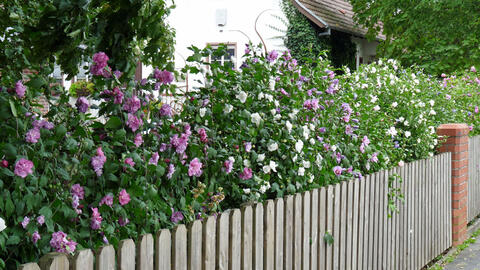Hibiscus Hedges: Tips on Planting and Care
A Hibiscus hedge combines a magnificent bloom with privacy. Continue reading to find out which Hibiscus species are suitable for hedges and how best to maintain them.

Hibiscus hedges provide gardens with a decorative privacy screen
Hibiscus hedges start to flower in June with beautiful pink, blue or white blooms. These last until September, when other summer flowers have long since finished blooming. The different varieties are great for mixing and can be combined for a harmonious, tone-on-tone appearance. Hibiscus hedges not only provide privacy in the garden, they are also easy on the eye with their colorful blooms. We’ve summarized the things to keep in mind when planting and maintaining Hibiscus hedges.
Rose Mallow or Rose of Sharon (Hibiscus syriacus) and its varieties are the best choice for a Hibiscus hedge as they are cold hardy and respond well to pruning. The shrubs grow relatively slow, but after a few years, they reach a height of 59 to 79 inches and provide a good level of privacy. However, the downside is that Hibiscus hedges only bloom seasonally – they are deciduous. New shoots appear relatively late, in May, and at higher altitudes often not until early June.
Hibiscus hedges thrive in wind-sheltered locations in the sun or partial shade with humus-rich, well-drained soil. When spaced a good 20 inches apart, hibiscus hedges can later be trimmed to a width of 24 inches without any difficulty, which also makes them great for small gardens. Of course, you can also let the hibiscus hedge grow wider or plan for a free growing hedge from the outset. Spring is the best time for planting hibiscus hedges. The plants then have all summer to grow and until winter to get used to their new location. Our tip: water the soil well after planting.
Use twine to mark out where you are planting the Hibiscus hedge. In order not to misjudge the number of plants required, first mark the positions of the individual plants with sticks. This is important, as a free growing hedge normally needs one or two more plants than a hedge that is surrounded by walls or fence posts.

The most important rule in the care of Hibiscus hedges: plenty of water. Freshly planted Hibiscus hedges should be kept moist for at least two weeks. Drip irrigation tubing makes it very easy to integrate your Hibiscus hedge into an automatic garden watering system. Hibiscus hedges respond quickly to drought by dropping their flowers. Don’t let it get to this point and water the hedge as soon as its leaves start to wilt.
Yellow leaves are usually not indicative of disease, but rather the wrong location in the garden: is the hedge is too dark, the Hibiscus is not getting enough light and is also suffering from a nutrient deficiency. Occasionally, aphids and spider mites attack the buds and fresh shoots of the Hibiscus hedge. You should treat the plants as soon as you discover the pests, while also reviewing your care measures: pests tend to infest thirsty plants that have been insufficiently fertilized.

Hibiscus hedges are trimmed in spring before the shoots appear, you can trim a good third of the previous year’s side shoots. This encourages flowering and compact growth, and you can also cut off any frozen branches that have no buds or only withered buds.
Hibiscus Syriacus is considered cold hardy to -4 degrees Fahrenheit in slightly sheltered locations. However, the plant only becomes more hardy with age, so young Hibiscus hedges in unprotected locations are very grateful for a warm coat made from leaves, brushwood or even bark mulch to protect them in winter. Black frost can cause established hedges to lose at most a few branches - these can be cut off.



